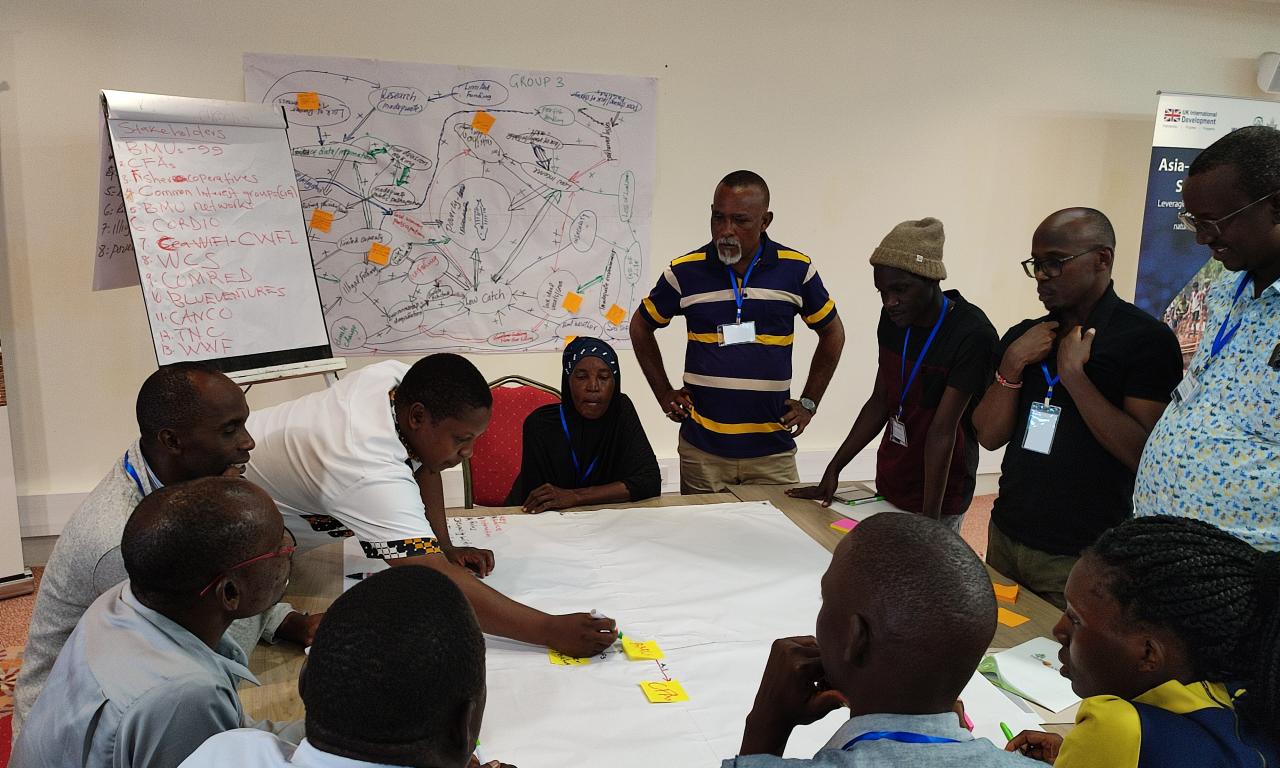
- Under the Asia-Africa BlueTech Superhighway project, WorldFish and Wildlife Conservation Society hosted a participatory workshop in Mombasa, Kenya. This event brought together 30 stakeholders, including fishers, researchers, and NGO representatives, to discuss sustainable and equitable management strategies for small-scale fisheries (SSF).
- The workshop highlighted the overlooked issues faced by coastal SSF communities in Kenya. Participants identified a range of challenges such as illegal fishing, weak governance, and data inadequacies. The need for robust data to inform policy-making and promote sustainable fishing practices was emphasized.
- The initiative aims to integrate community feedback and enhance the role of Beach Management Units (BMUs) in effective fisheries co-management. It focuses on filling data gaps, sharing knowledge, and employing innovative solutions to improve the livelihoods of fishermen and women, while also conserving marine resources.
Under the Asia-Africa BlueTech Superhighway (AABS) project, WorldFish in collaboration with Wildlife Conservation Society conducted a participatory workshop in Mombasa, Kenya, to map the issues and potential solutions to improve the livelihoods of thousands of people depending on marine small-scale fisheries (SSF). Thirty stakeholders constituting fishers, women fish processors, researchers, state and county fisheries managers and conservation NGOs focused their discussions around improving SSF data for a more sustainable and equitable management of marine resources during this first AABS dialogue in Kenya, held November 21-23.
Diversity of Challenges, from Lamu to Shimoni Communities
For a long time, coastal small-scale fisheries communities have been relatively ignored in the development of the aquatic food sector in Kenya, overshadowed by inland fisheries like Lake Victoria, which represent over 90% of domestic fish production.
With words like "illegal fishing”, “weak governance”, “conflicting rules between the state and fishing communities”, “poor data”, “overfishing”, “insecurity”, “lack of reliable markets” and “limited livelihood options”, the workshop participants painted a vulnerable and poorly regulated sector. Their vulnerability is worsened by changing climate as recent extreme floods claimed lives and cut some villages off for days. Reports of ‘waves being stronger’, preventing boats from going out and ‘warmer waters bleaching seaweed’ negatively impacting women engaged in seaweed farming abound. Top-down policies like the ban on the use of monofilament nets or the obligation to get expensive coxswain qualifications are not well understood and exclude small fishers, said Said Mothe, fisher from Kilifi county.
For women, life is not easy either. To support her children, recently widowed Jabu Ushora, a mama karanga (fish seller), buys daily fish or octopus from the Bamburi landing site in Mombasa and sells it fried at a street market a few kilometres away. She complained about the unpredictable supply and consumer demand through the year, making her livelihood very uncertain. She would like affordable cool-boxes to avoid her fish being spoiled, solar lights to replace her kerosene lamp and marketing training to help her improve her business.
Zara Kassim Mwanamvua and Sauda Hassan process traditional sardine-like fish in Jimbo, the last beach management unit (BMU) before the Tanzanian border, in Kwale county. They boil and dry these small fish on mats laid on the ground, then sell them as far as Malindi over 110 km away, packed in small parcels sent by bus. They are desperate for better drying technology, especially during the peak rainy season when there are days they may lose all their produce.
Although “some villages are making efforts to recruit more women into fishing” as stated by Mwanamvua who is treasurer of Jimbo BMU, there is a deep gender divide in Kenyan coastal fisheries.
Rahma Adam, WorldFish Social Inclusion & Market Scientist, wants to gather more evidence on their constraints and contributions as part of AABS’ women empowerment in fisheries and aquaculture component.
Filling Data Gaps to Advocate Support for SSF in Kenya
The patchy SSF data fails to capture the importance of this sector and the complexity of socio-ecological contexts, with richly diverse tropical fisheries across coastal communities along the 600 km coastline of Kenya. This means policy makers, fishers and conservationists can’t properly assess the right strategies for sustainable fishery management. More robust data on coastal SSF would help mainstream its values in national policies in terms of food security, livelihoods and sustainable management.
“The first step is to understand who is collecting what data and where, and the data gaps from the sea to the aquatic foods marketplace”, explained Alex Tilley, WorldFish senior scientist who is leading Digital Coasts, one of the four work packages of AABS.
“We also need to map past experiences and ongoing initiatives to avoid duplication” underlined Timothy Manyise from WorldFish, who is coordinating the participatory systemic change mapping exercises, an essential initial step underpinning AABS’ action plans in countries.
For instance, the Kenya Marine and Fisheries Research Institute (KMFRI) tested with some success, improved fish smoking and solar drying pilots in Lamu, Tana and Kwale counties several years ago. Are these technologies still used and why were they not scaled up?
Through South-South collaboration, AABS will not only look at transferring knowledge and innovations from one country to another, but also identify what’s working and is worth scaling in country.
AABS is implementing a bottom-up theory of change design to integrate communities’ feedback from an early stage. Participants were shown a satellite map of a fishing trip from a Shimoni fisher the previous week, captured by a low-cost vessel tracking device, part of Peskas SSF automated digital data system tested and now adopted by the government in Timor-Leste. While Peskas caught their attention, Kenyan fishers were cautious about the idea of installing a tracking device on their boats and asked for field training at landing sites with demonstrations and user-led video screenings so that they could see testimonials from peers explaining how the device helped them.
Beach management units (BMUs) at the centre of effective fisheries co-management
Among the key stakeholders identified, BMUs and the county fisheries department are key SSF institutions for data capture to enable a more evidence-based co-management of marine resources. BMUs are fisheries and beach user groups mandated by the Fisheries Management and Development Act, 2016, to record fish capture, implement state regulations and co-manage coastal natural resources. To fish and operate, fishers and fish processors must be registered in one of the 98 BMUs along the Kenyan coastline.
BMUs, however, often have weak capacity and governance, leading to low enforcement of conservation measures. There is also data fatigue as fishers asked for their catch records do not get much feedback afterwards.
AABS’ knowledge sharing vision is a two-way flow of information so that the improved fishing data platform can generate real-time advisories for different types of stakeholders, including fishers, governments and conservationists. Innovation may also come from communities’ local knowledge, such as how fishers record a change in sea currents or women fish sellers adapt to seasonal fish supply.
Fishermen and women like Said Mothe, Jabu Ushora or Zara Mwanamvua can provide, as well as gain, crucial learnings from peers across Kenya and other countries in the Global South.
The Mombasa workshop was the first stepping stone towards an interactive and inclusive knowledge ecosystem that AABS will co-develop to make small-scale fisheries work better, both for communities and nature.
